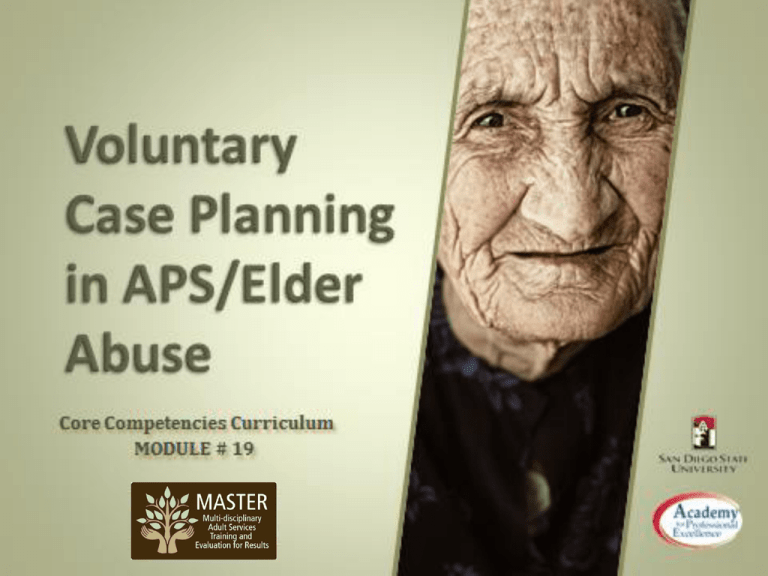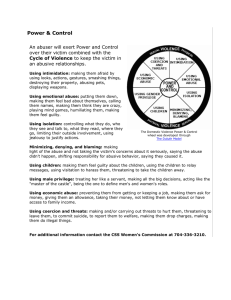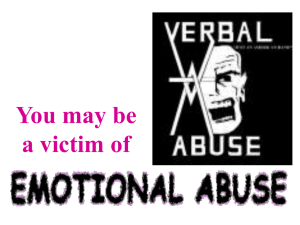Document 17824968
advertisement

This training was produced by the Academy for Professional Excellence under 2009-SZ-B9-K008, awarded by the Office for Victims of Crime, Office of Justice Programs, U.S. Department of Justice. The opinions, findings, and conclusions or recommendations expressed in this training are those of the contributors and do not necessarily represent the official position or policies of the U.S. Department of Justice. The National APS Training Project is a project of the Academy for Professional Excellence, San Diego State University School of Social Work 2 Schedule for the day CEU instructions Location of restrooms Set cell phones to vibrate Introductions 3 Transfer of Learning Activity Satisfaction Survey Embedded Evaluation 4 What are the first three letters of your mother’s Smi maiden name? Alice th What are the first three letters of your mother’s Ali first name? ce Smith What are the numerals for the DAY you were born? Nov 29th Trainee ID Code S M I A L I 2 9 5 Identify the factors that influence intervention needs Discuss strategies to engage the victim in developing mutual goals to decrease risk of abuse Determine appropriate interventions that would decrease risk of abuse Explain when and how to use a Domestic Violence Safety Planning tool Client wishes Perpetrator issues Urgency of the Situation Professional ethics Cultural Considerations Adapted from Elder Abuse Prevention: Emerging Trends and Promising Strategies, Lisa Nerenberg, 2008 Mental capacity/ ability & willingness to consent Risk factors Resources and support systems Levels of consent Capable and consenting Capable and nonconsenting Incapable and consenting Capacity can fluctuate over time Varied reasons for lack of consent Incapable and nonconsenting Health and functional ability Dementia and mental health problems Dependency Relationship to abuser Isolation/lack of social support Age/gender/ethnicity Recent losses Informal networks Public/ private services Benefits and limitations Finances Availability Willingness to spend Eligibility and waiting lists Relationship to the victim Mental health/substance abuse Dependency Motives for abusing Willingness/ability to change Access and level of threat Financial gain Mental illness/substance abuse/other impairment Caregiving issues Dependency Interpersonal dysfunction Power and control Victim’s wishes for abuser Abuser’s willingness to stop abuse, learn new skills, get treatment, pay back Can treatment be monitored Abuser’s admission of wrongdoing Continued or potential access to victim Victim’s ability/desire to deny access Weapons in the home Mitigating factors Others in home to monitor Assets secured Lack of supervision Imminent danger of violence Imminent eviction Unsafe environment Imminent risk of serious financial losses Autonomy vs. protection Least restrictive alternative Benefits and risks of each alternative Competing and conflicting principles Self-awareness Whose needs are being met? Whose life is it anyway? Values Attitudes about abuse Which services are acceptable, compatible, accessible Who should provide them and how Select a recorder and reporter Read the case Complete the exercise Rebuilding Recognition Life without Mistreatment Reluctance Life with Mistreatment Developed by Risa Breckman, 1983 Characteristics Has not acknowledged abuse Denial Self-blame Low self-acceptance Ambivalence Isolation Belief that abuser needs help Interventions Provide emergency assistance Provide information on Elder abuse Options Accessing help Implement “keep in touch” method Provide services/make referrals Characteristics Problem recognized as complex Realization that problem can’t be managed alone Continued ambivalence Lessening of denial, self-blame Desire to share with others Intervention Provide emergency assistance Explore options extensively Provide services according to need and/or make appropriate referrals Characteristics Reshaping identity Seeking lifestyle alternatives Diminished self-blame High self-acceptance Development of support system Interventions Provide emergency assistance Assist/support with adjustments and life changes New housing arrangements Enforcement of orders of protection Provide services according to need/make referrals Bring your L.O.A.F. Listen Observe Ask Facilitate Let’s change our frame of reference! Difficult Manipulative Resistant CoDependent Passive Poor judgment Hardiness and adaptive skills Willingness to learn and use resources Loyalty and forgiveness Survival instincts Kindness and compassion Strong faith or religious values Creativity What are the systems? Aging network Financial assistance Mental health care Medical care Domestic violence services Legal assistance Internet search Service Directories Known service providers MDT Coworkers Supervisor Based on need Based on income Based on residence Based on age Based on disability Immigration status Stay up to date Funding time limited Funding income limited Funding finished Brochures/directories out of date Maintain professional ethics Do not overstate or understate Complexity of cases Creativity “Outside the Box” Thinking Match Client Needs to Available Services Begin your own resource directory Select 6 service needs and research a resource that will meet the need Complete Activity Sheet and return to trainer The Case Plan Should Be: Collaborative Problem oriented Appropriate to client’s functional level and dependency needs Consistent with culture and lifestyle Realistic, time-limited, and concrete Dynamic and renegotiable Inclusive of follow up Maximizing independence Resolving crises and emergencies Healing, empowering, supporting victims Providing choices Helping victims save face Cultivating new resources Preserving, protecting, recovering assets Ensuring safety/risk reduction Hidden/ unintended consequences Ethical dilemmas Workability Whose needs are being served Plan B What is safety planning? Where Will The Victim Live? Money Health Who Else Is Affected By The Abuse? Legal Build rapport and listen to the victim Learn what the victim fears Ask what the victim wants to do Think creatively together about a variety of options and ideas Build a safety plan that is victim centered Telling the victim what to do Helping a victim accomplish your goals Simply referring the victim to local agencies Ignoring cultural, spiritual or generational values Recommending strategies that could increase the risk for the victim Blaming the victim Each group needs: Irene Moderator to keep the safety planning on track Recorder Primary interviewer Secondary interviewers Irene’s husband passed away unexpectedly. Irene’s son is drinking more and has become more aggressive. Based on what Irene wants, develop a new plan. Irene’s son has gotten a job and is drinking less. Irene is lonely. Based on what Irene wants, develop a new plan. Questions? What have you learned? Please complete: Self Assessment of Learning Trainee Satisfaction Survey



